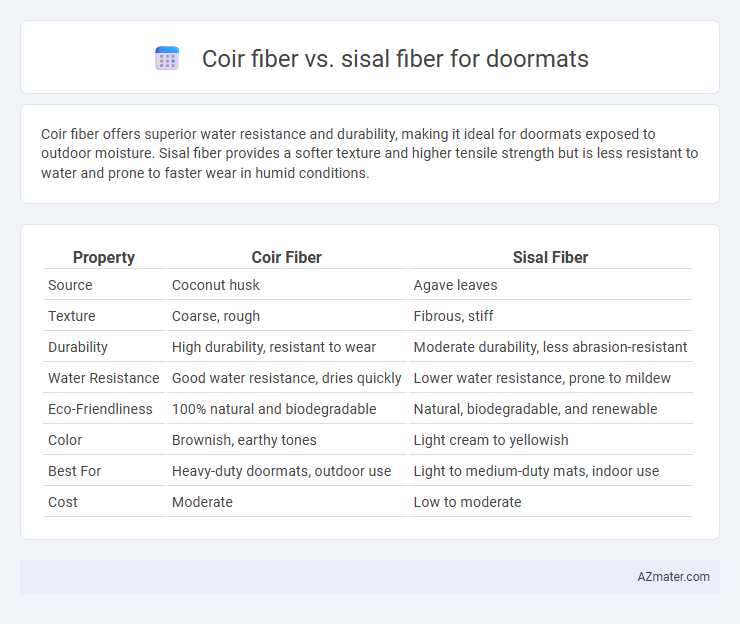Coir fiber offers superior water resistance and durability, making it ideal for doormats exposed to outdoor moisture. Sisal fiber provides a softer texture and higher tensile strength but is less resistant to water and prone to faster wear in humid conditions.
Table of Comparison
| Property | Coir Fiber | Sisal Fiber |
|---|---|---|
| Source | Coconut husk | Agave leaves |
| Texture | Coarse, rough | Fibrous, stiff |
| Durability | High durability, resistant to wear | Moderate durability, less abrasion-resistant |
| Water Resistance | Good water resistance, dries quickly | Lower water resistance, prone to mildew |
| Eco-Friendliness | 100% natural and biodegradable | Natural, biodegradable, and renewable |
| Color | Brownish, earthy tones | Light cream to yellowish |
| Best For | Heavy-duty doormats, outdoor use | Light to medium-duty mats, indoor use |
| Cost | Moderate | Low to moderate |
Introduction to Coir and Sisal Fibers
Coir fiber, extracted from the outer husk of coconut shells, is renowned for its durability, water resistance, and coarse texture, making it ideal for doormat production. Sisal fiber, derived from the leaves of the Agave sisalana plant, offers high tensile strength, natural stiffness, and biodegradability, also suitable for sturdy and eco-friendly doormats. Both fibers provide sustainable options with unique properties, where coir excels in moisture handling and sisal in wear resistance.
Source and Production of Coir vs Sisal
Coir fiber, derived from the outer husk of coconut shells, is harvested primarily in coastal regions of India and Sri Lanka through a wet process that softens and separates the fibers, making it highly durable and water-resistant. Sisal fiber originates from the leaves of the Agave sisalana plant, predominantly cultivated in Brazil, Tanzania, and Mexico, and is extracted by decorticating the leaves followed by drying and brushing to produce stiff, coarse fibers ideal for rough-textured mats. The eco-friendly production of coir involves minimal chemical use and leverages coconut husk waste, whereas sisal production requires large-scale plantation and energy-intensive mechanical processing, influencing overall sustainability and fiber characteristics in doormat applications.
Physical Properties Comparison
Coir fiber, derived from coconut husks, exhibits higher tensile strength and elasticity compared to sisal fiber, making coir more durable and resilient for doormat use. Sisal fiber, sourced from the agave plant, offers superior moisture absorption and a softer texture, enhancing comfort but reducing longevity under heavy foot traffic. The coarse, rough texture of coir provides excellent scraping ability for dirt removal, whereas sisal's smoother surface retains less debris but wears down faster over time.
Durability and Lifespan
Coir fiber, derived from coconut husks, offers superior durability and water resistance compared to sisal fiber, making it ideal for doormats exposed to heavy foot traffic and moisture. Sisal fiber, sourced from Agave plants, is naturally strong but less resistant to moisture, which can lead to faster deterioration and reduced lifespan in damp environments. Overall, coir doormats typically last 3-5 years, while sisal doormats may show wear within 1-2 years under similar conditions.
Water Absorption and Resistance
Coir fiber exhibits superior water absorption and excellent resistance to mold and mildew, making it ideal for doormats in wet or humid conditions. Sisal fiber, while moderately absorbent, offers greater durability and resistance to wear but is more susceptible to moisture damage and quicker deterioration when exposed to water. For doormats requiring robust water resistance and longevity, coir fiber is generally the preferred choice.
Cleaning and Maintenance
Coir fiber doormats excel in trapping dirt and debris due to their coarse texture, making them highly effective for cleaning shoes before entering a home, while sisal fiber mats have a smoother surface that offers moderate dirt retention but require more frequent cleaning to prevent fiber degradation. Coir mats are naturally resistant to moisture, reducing mold and mildew buildup, which simplifies maintenance compared to sisal mats that absorb moisture and may develop odors if not dried properly. For longevity, coir doormats need occasional shaking or vacuuming, whereas sisal mats benefit from gentle brushing and spot cleaning to maintain fiber integrity and appearance.
Environmental Impact and Sustainability
Coir fiber, derived from coconut husks, is biodegradable and renewable, making it a highly sustainable choice for doormats due to its natural resistance to mold and water. Sisal fiber, sourced from the agave plant, also offers biodegradability and a lower environmental footprint as it requires minimal water and pesticides during cultivation. Both fibers contribute positively to reducing synthetic material reliance, but coir's durability and waste utilization from coconuts enhance its eco-friendly profile in sustainable doormat production.
Comfort and Texture for Doormat Use
Coir fiber offers a rougher, more abrasive texture ideal for scraping dirt off shoes, providing excellent durability and firm footing for doormats. Sisal fiber, in contrast, is slightly softer and smoother, delivering a more comfortable feel underfoot while still maintaining good strength and natural resistance to wear. Both fibers are breathable and eco-friendly, but coir excels in rugged texture for heavy-duty use, whereas sisal enhances comfort with a gentler surface for lighter foot traffic.
Cost Effectiveness
Coir fiber doormats typically offer greater cost-effectiveness due to their abundant availability and lower production costs compared to sisal fiber. Sisal fiber doormats, while more durable and resistant to wear, often carry higher prices reflecting its complex processing and limited supply. For budget-conscious consumers seeking a balance between affordability and durability, coir fiber remains the preferred choice for doormats.
Which Fiber is Best for Your Needs?
Coir fiber, derived from coconut husks, offers superior water resistance and durability ideal for outdoor doormats exposed to moisture and heavy foot traffic. Sisal fiber, sourced from the agave plant, provides a softer texture and natural resistance to pests, making it suitable for indoor use where comfort and aesthetics are prioritized. Choosing between coir and sisal depends on whether you need longevity and weather resistance (coir) or a gentle, eco-friendly surface for light use (sisal).

Infographic: Coir fiber vs Sisal fiber for Doormat
 azmater.com
azmater.com